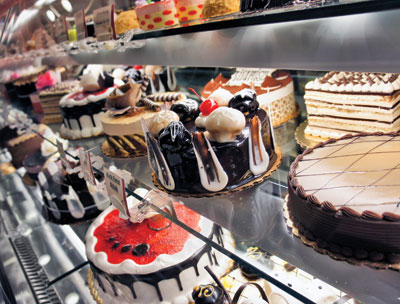
The look of success
March 28, 2011
By Michelle Brisebois
Whether we’re talking about a bank, a restaurant, or a bake shop, it’s all retailing.
Whether we’re talking about a bank, a restaurant, or a bake shop, it’s all retailing. Retail spaces are where consumers interact with us and make purchases. A properly merchandised store functions like a silent salesperson helping to convert shoppers into buyers, but so many businesses neglect to plan their merchandising strategy carefully.
 |
|
| Great merchandising acts like a silent salesperson, deftly converting shoppers into buyers.
|
It’s not enough to make the store pretty. The web resource www.bussinessdictionary.com defines merchandising as: “Activities aimed at quick retail sale of goods using bundling, display techniques, free samples, on-the-spot demonstration, pricing, shelf talkers, special offers, and other point-of-sale methods.” Merchandising is about having a wide variety of products available for purchase. It’s where art meets science in displaying those products in such a way that it stimulates interest and entices customers to make a purchase.
When we think of decorating, we usually think of homes, not retail spaces. The real estate industry knows that to sell a home, it must be merchandised instead of simply being decorated. Home staging is the art of merchandising a home for sale. The stager takes out the knick-knacks and personal touches and arranges the space so that the potential buyer can see themselves using the space. The first step in making a buyer want to make an offer is ensuring he or she can visualize living there. Likewise, your customers must visualize themselves eating, gifting or serving your baked goods.
Knock-your-socks-off merchandising doesn’t need to be expensive or involve store renovations. It’s really about hierarchy of message and being clear as to what steps your customers are taking psychologically as they navigate your business space. The first order of business is to get people in the door. To maximize capture rate, it’s wise to capitalize on window displays first, to get the consumer’s attention and then to draw customers into the store. It’s important to remember that displays are often seen under less than optimal conditions, such as whizzing by in a car or in poor weather. If the message to be conveyed is not big, bold, short, simple and memorable, your effort is wasted.
The biggest mistake retailers make when it comes to merchandising is to pile goods at the entrance in the hopes that it will entice people in. You think you’re saying “come and get it,” but customers may be thinking, “too many barriers to get past,” and walk right by. Take a stroll through a mall some time and notice those retailers who pile stuff at the front of the store. Luggage retail stores are notorious for this. Does it really look welcoming or does it just look junky? If you have a feature product to showcase, then by all means have a small display with clear signage at the entrance. Otherwise, make your entrance look welcoming and open with some bright floral accents but minimal clutter.
Once you’ve got customers across your lease line, consider their decision-making process carefully.
Organize your displays in a customer-centric manner. Paco Underhill, a guru in the science of shopping, refers to adjacencies when he speaks of effective merchandising techniques. Underhill discusses adjacencies as having the following four hallmarks. First, items need to be displayed in a way that groups them as people use them. Customers are likely on a mission, not browsing, so figure out what they’re hunting for. You can usually tell by what questions are asked when somebody new comes in for the first time. Chances are the customer is thinking of an occasion. That occasion may be anything from a birthday to a casual dinner with friends. Why not organize your store into four or five sections with big signs dangling from the ceiling to direct customers to the appropriate section for their occasion? This is known in retailing lingo as wayfinding. In other words, you are helping customers quickly find their way to exactly what they need. Next, you need to have a sensible, logical order of presentation in order to increase sales. Sometimes irrational combinations work if you want to coax a consumer to purchase a more profitable item. An example of this strategy at work would be where a drugstore places the generic pain reliever next to the brand name. The generic is cheaper so the consumer will be drawn in by the brand name but choose the generic option because of price. It would seem to be a loss for the retailer because the sales value is lower, but because the generic pills are more profitable to the retailer, the consumer has done exactly what the store wanted. Conversely, display the jellies beside the breads because the two logically go together. Underhill’s third approach to merchandising is to arrange the store by considering what else may be on the visitor’s mind. For example, put the birthday candles next to the cake display. Finally, don’t let your merchandising plan become stale or dated. Make sure that you’re playing your strongest cards when it’s appropriate. If sweet goods fly in April because of Easter, then your feature display should change in April to reflect this trend.
Great merchandising is about telling a story visually. Always view it through that lens and make function over form your merchandising mantra.
Michelle Brisebois is a marketing professional with experience in the food, pharmaceutical, financial services and wine industries. She specializes in retail brand strategies.
Print this page
Leave a Reply